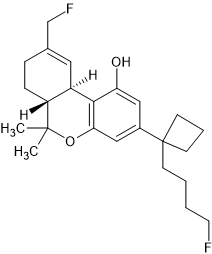Image 1 hosted in ImgBB

ibb.co
The above is some x200 Δ9-THC (according to a Greek medicinal chemist - you will have to find the name) and has a T1/2 of just over 600 hours. As far as I can tell, physically (as - 'in the petri-dish' & and 'the hit when you smoke in a bowl') it's more or less indistinguishable from normal honey oil with which it freely mixes.
The KEY difference is that the cyclobutyl (bond-angles explain why cyclobutyl is so good) makes it a super-agonist (i.e. it activates cells more than the bodies natural transmitter) and the fact that it lasts for 6-7 weeks.
I PRESUME that people who smoke dope morning noon and night wouldn't really notice a change. You would ONLY know that it was different if and when you stopped using dope. I suspect that after the first month you would just adjust (as the constantly stoned do) so it wouldn't be THAT scary. You would simply have to accept that you would be stoned for the rest of your life.. and their are worse things.
My wife brought me back some chocolate cake from Amsterdam and it was subtle but lasted for 12 hours. Didn't seem to affect my life in any negative manner and so I wouldn't mind one a day.
But of course, if you hit the oil-pipe to REALLY listen to your Pink Floyd and Greatful Dead albums in full detail, it might be disconcerting. Imagine that after a Friday night sesh you are just as stoned the following Thursday.... and the following Thursday.... and the following Thursday....
I PRESUME it was developed as a chemical weapon (papers are 79-83) because it's so potent that a fine mist of it would work. It would make for docile, compliant and non-aggressive workers. Of course, those with a predisposition to schizophrenia may not react well since the disease amplifies everything. I don't fear VX gas, I fear this (It's more potent than VX). I mean, since it won't show up on most tests, how do we know it's not 'standard issue'?
BTW Neuroleptics will not help. So maybe we are a generation of people all living stoned lives? I am almost certain that my memory used to be much better (but I forget) but then nothing much bothers me any more. I'm of the so-so generation.
How would we know? I just don't let it worry me...
But it isn't the MOST potent by a large margin. I know of some compounds over 18000 Δ9-THC BUT they are more easily detected. IF I sought to make an untraceable social-control drug, it would be something like this,
Super-agonism has nothing to do with super-potency per se. I know benzos less potent than diclazepam that are technically super-agonists but I didn't go with them because they are a 1 way street. When the body becomes used to something that sends a stronger signal, after a few months it can never recover...
That is why I'm not happy, but not outright alarmed by flunitrazolam. It's BAD, but it's an order of magnitude less than the WORST. Same with fentanyl. It's BAD, but their are super-agonists and if those were common, it would, in essence, make someone hooked for life (but maybe not a long time). They aren't even chemically complex. The term is simply derived from scientists discovering compounds that produced a response over and above the receptor's natural trigger....
Now a mixed benzo/opioid super-agonist - I presume some evil people seek it... but I'm not about to give them millions of souls and the $ billions associated with them, am I? I prefer to play the 'how potent can we make this REALLY simple compound'. As it is, I've got 11.5x M from a compound that costs $2500/Kg in precursors. Not THAT is useful. In a nation with few resources, an analgesic like hydroM that costs 1/10th the price has it's place...






